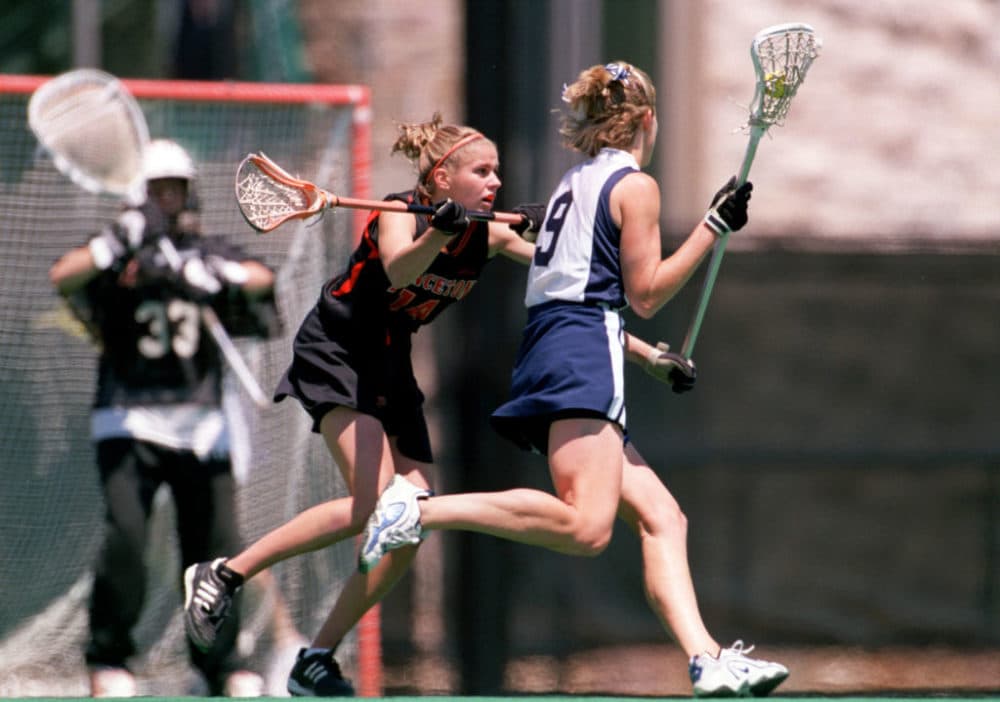Advertisement
Commentary
Title IX didn't fix everything

In the late spring of 1994, during the interregnum between exams and graduation, two teams met on a Princeton athletic field. The field was grass and its surface was rough. It was worn to bare dirt at both ends and the gulley on the far sideline was prone to flooding after a good rain. There were no stands at the edges of the field, just a simple yellow rope strung on wooden stakes cordoning off the playing arena from spectators.
The rope defined the field. And that season, the field defined us. Virginia Woolf might have written: “It is a field of your own.”
Over 18 games, our Princeton women’s lacrosse team played its best season, culminating in the program's first NCAA championship. The men’s team also won the NCAA title. So naturally, we were on the field that day to settle the only question that mattered: Who was better, the women or the men?
Bragging rights were on the line; but deeper forces were at work, too. We were the same age as Title IX, the 1972 federal legislation that had made it possible for half of us to be on the field.
Back then, we couldn't comprehend that despite two decades of legal and cultural work, Title IX had yet to make good on its promise of equality. The law banned sex discrimination in educational institutions and programs that receive federal funding. And yet, a chasm still existed between the way female and male athletes were perceived — and treated.
Why is the women’s Olympic figure skating long program 30 seconds shorter than the men’s?
Then, as now, a visible disparity persisted between the expectations set for male and female athletes. Why, for instance, do female cyclists compete on significantly shorter courses than the men? Why is the women’s Olympic figure skating long program 30 seconds shorter than the men’s? In track and field, why do women contest the heptathlon while men complete a full decathlon? Are women 70% as athletic as men? Perhaps most stunningly, why do female tennis players still play only best-of-three matches in the sport’s major championships, when the men play best-of-five?
To be fair, over the past half-century of Title IX much work has been done to narrow the gap: Venus and Serena Williams, Billie Jean King and the U.S. Women’s National Soccer Team fought for years to establish equal pay in tennis and soccer, respectively. Most recently, a sub-committee of the International Ski Federation (FIS), the international governing body for skiing, approved equal race distances for female and male skiers in the upcoming World Cup cross-country season. In addition to leveling up at shorter distances, the women will now ski the same mass start 50k marathon as the men, rather than the 30k they’ve been skiing since 1992. The U.S.’s most decorated Nordic skier, Jessie Diggins, reacted to the news by saying, “Not only can we ski 50km, but we can ski more.”
Diggins’ quip gets to the heart of the importance of sport: It gives you a sense of your own power. When women compete, they flex their confidence; they fuel the gas tank of their ambition; they expand — as all athletes do, regardless of gender — the contours of their ability. They believe they can do more.
Fifty years into Title IX, it’s clear we can do more. We can do better. Gone are the days when doctors warned a woman might grow a mustache if she ran farther than 800m, or that excessive exercise might cause her uterus to fall out. Access to athletic competition has endowed women with exactly the traits necessary to close the gender gap in sport: in letter, number and spirit.
Fifty years into Title IX, it’s clear we can do more.
Back in 1994, I knew my teammates to be driven, fierce and outspoken. Our decades in ill-fitting cleats and oversized Umbros had given us that same Diggins-esque undiminished sense of our own power. We trained year-round; we were in the weight room routinely. We were strong, and we knew it. It never occurred to us that we might be treated differently than our male counterparts.
Yet earlier in the season, months before we met the men’s team on our turf for college lacrosse’s reprisal of the Battle of the Sexes, we’d been returning from practice to our locker room on the underside of Baker Rink when we passed by the men’s ice hockey locker room. The door had been left casually ajar. Curious — and perhaps a bit irreverent — we stepped across the threshold and discovered ourselves in another world.
Whereas our locker room was an unadorned square of bare cinderblock lined with plain wooden cubbies the width of our shoulders, the men’s hockey locker room was palatial. It was carpeted and freshly painted in orange, black and white. Every double-wide cubby had its own seat and player nameplate. There was a weight room in situ. I remember feeling like we’d been yanked by a chain attached to a collar we didn’t know we were wearing.
Are women 70% as athletic as men?
When we inquired about the discrepancy, we were told that a men’s hockey alumnus had donated the funds for the locker room upgrade. An alum? With deep pockets? Our oldest alumna wasn’t even 40 yet; and given the 23% gender wage discrepancy that existed then — and persists unchanged today — it would be a long while before the phalanx of women’s sports alumnae were in any position to fund a locker room upgrade.
We realized then that all of our narrow focus on that small yellow lacrosse ball meant we’d taken our eyes off the bigger ball: gender equality in sport.
So when we took the field against the men’s team in early June of 1994, we may have assumed a light-hearted air while we warmed up and swapped jokes and equipment with our opponents, but once the game was underway, we were playing for more. The Jessie Diggins more. The we-deserve-to-be-here more. Like all good writers — like Woolf herself — we wanted to show, rather than tell, how good we were.
My recollection is that the game wasn’t even close. In fairness to the over-matched men, we had the advantage of playing on a field of our own.
Back in 1928, when Virginia Woolf delivered her series of lectures that came to be published as “A Room of One’s Own,” she advocated for women having “the habit of freedom and the courage to write exactly what we think.” As we contemplate what the next 50 years of Title IX will bring, let’s make a habit of that freedom. And let’s promise our daughters we’ll help them summon the courage to play exactly as they want: however far or long or fast or fierce they choose.
